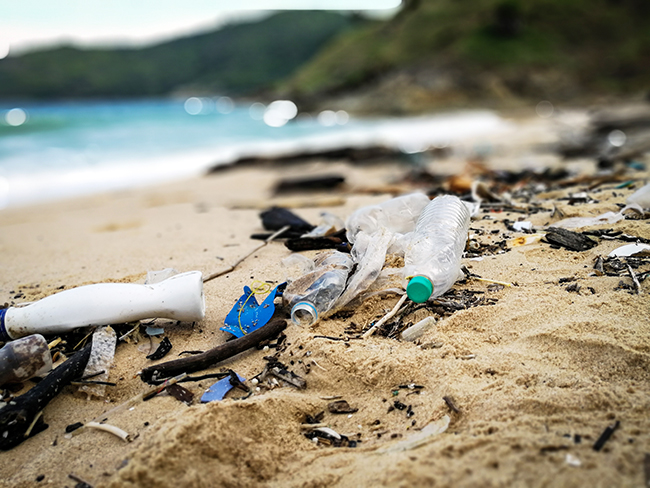The chemical BPA is widespread on beaches around the world
"When
we lie on the beach, we're not only lying on a bed of sand but a bed of
plastics."
Lynne Peeples for Environmental Health News
Beach sands around the world are laced with the chemical bisphenol-A (BPA), according to new research that calls attention to a less well-known source of exposure to the hormone-mimicking chemical.
Scientists
from South Korea and Japan analyzed sand and seawater samples from beaches in
19 countries. They found BPA to be ubiquitous. Substantial amounts of the
chemical—used in can liners, paper receipts and plastic products including food
and beverage containers—littered all of the beaches, peaking at upwards of 200
milligrams of BPA per kilogram of sand in Greece. That would be equivalent to
about 200 credit cards scattered across an American football field.
"The
high BPA concentrations found on sandy beaches in this study should be a global
concern," write the authors.
Scientists had already shown that people can be exposed to BPA through many sources including the air, food and water. "This is another study inventorying the extent of plastics contaminating our living environment," Rolf Halden, a sustainability scientist at Arizona State University, who was not involved in the study, told EHN.
"It makes us aware that when we lie on the beach, we're not only lying on a bed of sand but a bed of plastics."
BPA-containing plastics break down over time into tiny pieces, known as microplastics and nanoplastics, often with the help of the sea, surf and sand. The sand samples tested by the researchers included these fragments mixed with sand, as well as sand particles on which BPA and other chemicals have hitched a ride.
They discovered
that BPA concentrations were significantly higher in the sand than in seawater,
and varied widely between beaches. A factor of nearly 10,000 separated levels
in sands sampled from Greece and Slovenia, for example. Samples from six U.S.
beaches ranged between 0.4 and 45 milligrams per kilogram, or parts per
million.
The
BPA concentrations uncovered in the new study surprised Thomas Zoeller, a
biologist at the University of Massachusetts Amherst. "Parts per million
quantities, in many of these places, is pretty outrageous," Zoeller, who
was not involved in the study, told EHN.
Zoeller
noted that exposure to such highly contaminated sand could be enough to cause
health effects. However, he also cautioned that the study faced some
significant limitations. "It's difficult to extrapolate from these
numbers. They don't represent some average for a country, or even a single
beach," he said. "Still, everywhere they looked they found it."
In a statement to EHN, Steven G. Hentges, senior director of the Polycarbonate/BPA Global Group at the American Chemistry Council, an industry trade group, said that "government agencies around the world consider BPA to have a low potential to accumulate to any appreciable extent in organisms that come into contact with it in the environment."
BPA is "one of the most widely
studied chemicals in the world, and government scientists around the globe have
found that it does not pose a health risk at typical exposure level," he
stated.
Related: How willful blindness keeps BPA
on shelves and contaminating our bodies
Thousands of peer-reviewed studies from academics, however, have concluded that absorbing or ingesting BPA may harm people at doses 20,000 times lower than what the U.S. Food and Drug Administration (FDA) says is safe—doses comparable to levels at which most of us are exposed.
In November 2019, EHN published a year-long investigation which
found U.S. regulators were willfully ignoring research that increasingly links
low-dose BPA exposures to harmful health impacts ranging from birth defects to
cancer.
"This is a chemical people should not be exposed to," Frederick vom Saal, a professor of biology at the University of Missouri-Columbia, told EHN. He lamented the lack of progress in the U.S. on regulating BPA.
"There are
other parts of the world that are taking this seriously," said vom Saal,
who was not involved in the new study. France banned the use of the chemical in
food and beverage packaging and utensils after an assessment by the French
Agency for Food, Environmental Health and Safety determined that it is
hazardous at much lower levels than the FDA considers hazardous.
Beachgoers may be particularly at risk due to the use of sunscreen and other oils and lotions. Vom Saal published a study in 2014 that found chemical mixtures used in a variety of personal care products facilitate the movement of BPA and other chemicals through the skin. More than 300 different chemicals can act as permeation enhancers.
The use of hand sanitizer before handling receipts can
increase BPA absorption through the skin by up to 200-fold, according to vom
Saal's study. Beachgoers today, amidst a pandemic, may well be lathering up
with sanitizer, too.
"BPA
is a very sticky chemical," said vom Saal. "So, would it stick to
sand? Absolutely. And if you're using sunscreen or skin lotions or hand sanitizer,
then this stuff goes right through your skin."
Meanwhile, Halden's research has detected BPA and other molecules from commonly used plastics in human liver and fat tissues. More recently, his team detected plastic as well as BPA in all 47 samples they took from human lungs, liver, spleen and kidneys.
"These
are materials we're using on a tremendous scale without thinking about their
afterlife and the consequences they pose to our health," said Halden.
Bum
Gun Kwon from Chosun College of Science and Technology in South Korea, and
author on the study, expressed the same concern. "Although there may be
differences in degrees, large amounts of discarded plastic are too
common," he told EHN in an email.
"Strict
new rules for the use of sandy beaches should be set and followed," said
Kwon. "For example, rules restricting the use of plastic materials derived
from petroleum."
Related: Novel analysis adds to evidence of chemical's health effects
